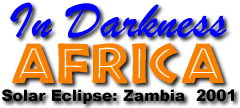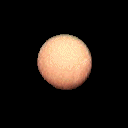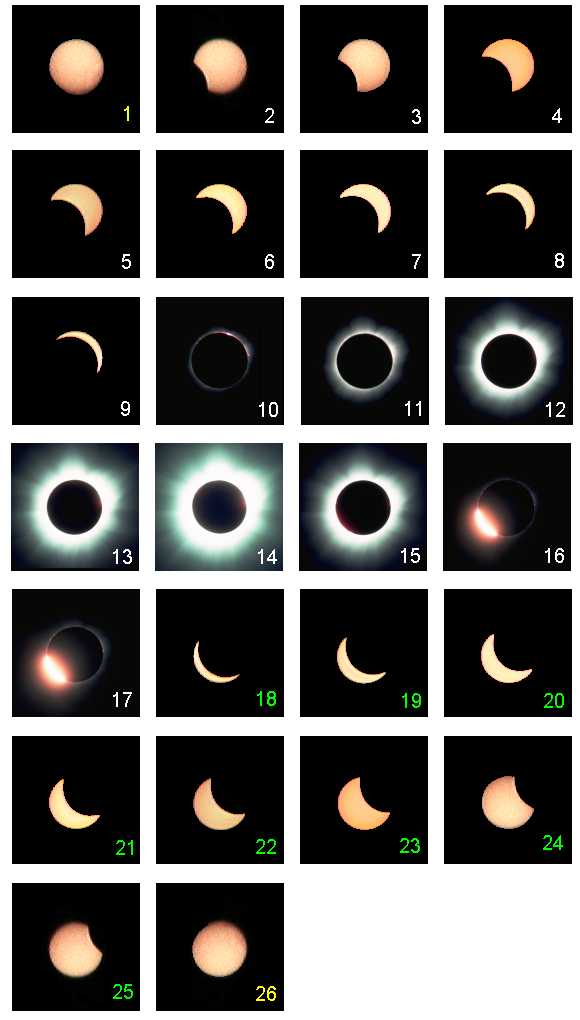
About the Animation


|
Eclipse 2001 About the Animation |

|
| by John Walker | ||
The animation at the top of the Eclipse Photo Gallery was created from a selection of slides taken during totality plus a series of snapshots of the partial phase of the eclipse. Between first contact (when the Moon first began to occlude the Sun's disk) and second contact (the start of totality, where the Sun's disc was entirely hidden by that of the Moon), I used the Olympus 3040 digital still camera also employed for the Images of Africa photos to capture the partially eclipsed Sun.
I zoomed the camera's lens to its maximum optical telephoto setting, equivalent to 105 mm focal length on a 35 mm camera. ("Digital zoom" merely inflates the captured image with no additional resolution, just like scaling up with an image processing program. This never makes sense unless you lack such a program.) I didn't have a solar filter for this camera, so I hand-held a much larger Orion solar filter in front of the lens for each exposure. I fix-focused the camera to infinity since experiments prior to eclipse day indicated that autofocus worked poorly with this ad hoc lash-up.
I had hoped to capture images of the partial phase every five minutes beginning with the uneclipsed Sun, but late arrival at the observing site resulted in first contact occurring before I was able to unpack everything and set up the camera. Various distractions during the partial phase and difficulty in getting images of the Sun through the hand-held filter free of scattered light or reflections disrupted the intended regular schedule. Still, I managed to obtain eight more or less usable images between first and second contact, if not equally spaced, at least indicative of the progress of the eclipse and illustrating the motion of the Moon across the solar disc. These images comprise frames 2 through 9 of the animation and are numbered in the tableau of frames below in white. With its modest telephoto lens, the image of the Sun produced by the digital camera was small--the partial eclipse frames in the animation are directly cropped from the full 2048×1536 image captured by the camera without any scaling.
From a few seconds after the onset of totality until moments before it ends, the appearance of the eclipsed Sun changes only subtly. But unless you've worn an eyepatch or taken other measures to dark-adapt your eyes, the corona will seem to "come out" and grow during totality. This is entirely due to perceiving increasingly fainter light from the extended corona as the eye dark adapts. In the animation, I simulate this effect by presenting images of totality in a progression from short to longer exposure times, which also happens to be the order in which they were taken; these comprise frames 10 through 14 of the animation.
To represent the end of totality, I briefly show a medium length exposure taken just before third contact, frame 15, where the lower left limb of the Sun is beginning to brighten as the Moon is about to uncover the photosphere, then frames 16 and 17 illustrating the diamond ring. The latter two are actually swapped from the order in which they were taken. Frame 16 is a 1/1000 second exposure and frame 17 is a 1/500 shot taken just before, but the difference in exposure time gives the impression of the diamond ring brightening as the Moon uncovers the Sun.
Now on to the really bogus stuff: totality ended at 15:13 local time and we needed to return to Mfuwe that same day. This meant we had to pack up our gear, drive back to Lusaka airport, board the King Air, then fly to Mfuwe airport. Mfuwe airport closes at night, and since the eclipse occurred on the shortest day of the year in the southern hemisphere, this meant our schedule would be extremely tight, even before adding in a flat tyre on the way to the airport, chaotic "invent your own lane" traffic on the Great East Road back to Lusaka, or wall to wall people in Lusaka airport. (Okay, we did anticipate the latter, and our expectations were entirely borne out.)
Adding up only the anticipated items made it clear we wouldn't be able to stay through the post-totality partial phase of the eclipse--in fact, we began to pack up minutes after the end of totality. As a result, I have no genuine photographs whatsoever taken between third and fourth contact. So....I took my handy-dandy image processing program and manufactured a set by flipping the ones I took between first and second contact (frames 2 through 9) and inserting them, in reverse order, as frames 18 through 25, numbered in green in the table below.
Just one more thing...since the eclipse was already underway by the time I set up the camera, we were in the air when it ended, and the Sun had set before we landed at Mfuwe, I had no picture at all of the uneclipsed sun on eclipse day. Rather than wait for a clear day to take a bogus picture of the Sun long after the eclipse from the other hemisphere (which could be a long wait in any case given the weather this time of year in Switzerland), I manufactured the uneclipsed full Sun which appears as frames 1 and 26, labeled in yellow, by mirroring frame 2 and putting back the bite taken by the Moon in that image.
With this source material in hand: genuine and bogus, I was then ready to assemble the animation. I'll continue with the details of that process below the table of frames.

Since the images of the eclipsed Sun had many times the resolution of the snapshots of the partial phase, I measured the size of the Sun's disc in the partial frames (since all were taken at the same zoom setting, this was consistent) and the size of the shadow of the Moon in the images of totality (which, at the resolution of the animation, is the same as that of the Sun's disc). I then scaled the frames of totality by the ratio of these sizes, obtaining a complete set of frames all at the same scale.
The images of totality were all taken with the camera fixed on the tripod, allowing the Sun's position within the frame to shift due to its apparent motion. The motion of the Sun during the 3½ minutes of totality as seen through a 500 mm lens fits easily within a 24×36 mm frame, so there's no need to waste any of totality aiming the camera. In the partial phase photos I roughly centred the Sun in the viewfinder for each exposure, but the results were far from precise.
Simply using the raw images as frames in an animation would result in the Sun's jumping around from frame to frame. That wouldn't do, so I needed to register the frames so the Sun's disc was centred in each one. I created a multi-layer image using Jasc Paint Shop Pro with each frame of the animation on its own layer. I chose the first image of totality as a reference and dragged its layer to centre it, with all other layers hidden. Then, for each of the other layers, I enabled the layer, adjusted its transparency so I could "see through" it to the reference layer, then dragged the layer until the disc of the Sun in it exactly coincided with the reference.
With the frames now registered, I cropped the multi-layer image to a 128×128 pixel box with the Sun centred. Then, using Jasc Animation Shop, I created a blank animation with those dimensions and pasted the frames into it. All that remained was to tweak the transition time from frame to frame to achieve the desired effect, add a blank frame at the end to make the looping transition less abrupt, and export the result as an animated GIF file with appropriate tradeoffs between file size and image quality. The whole process, start to finish, took about four hours, but that included a number of false starts and blind alleys until I stumbled upon the trick of using a multi-layer image and transparency to register the frames. It would probably take less than an hour to remake the animation using the technique described here.